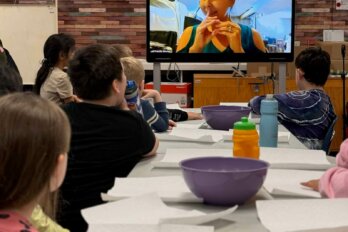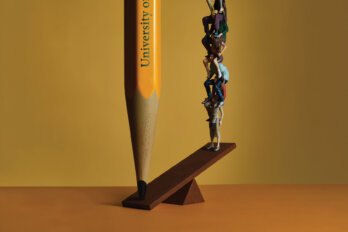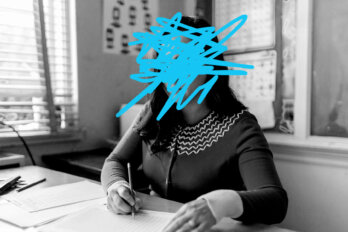As children marched back into classrooms this fall, armed with sharpened pencils and snappy geometry kits, it is worth considering Anne Watson’s view of teaching mathematics: “cognitive bullying,” she calls it. Watson, Reader in Mathematics Education at Oxford University, believes that math class is too often tantamount to low-level social violence. Teachers pound in multiplication tables and triangle theorems through rote learning, beating down errant kids with blood-red Xs on the page. The modus operandi is not unlike that of a chain gang, and the brutal motivation hardly inspires productivity.
“Whack! Whack! Whack! you got that wrong!!” demonstrates Walter Whiteley, director of Applied Mathematics at York University in Toronto. “You have to wonder what the impact of that is on society.” More math phobics than prodigies, probably. And what are the implications of that?
The answer might reside implicitly in this statement: Any renaissance in modern civilization rests on you learning mathematics. I remember hearing a pronouncement to that effect, somewhere. It seemed existentially and cosmically relevant, so I wrote it down. If I were a mathematician, perhaps my brain could rouse the synapses necessary to recall the exact source. Like a weekly shot of vitamin B12, math fortifies the brain.
For a layperson, my mind is reasonably well wired, mathematically speaking. Over the past four years I’ve been a foreign correspondent in the land of geometry. My introductory guide and interpreter was Donald Coxeter, the man who kept classical geometry from extinction in the last century. I tumbled down the mathematical rabbit hole when I followed the elderly Coxeter to geometry conferences in Banff and Budapest a few years ago. Coxeter was introduced before his lectures as “the greatest living classical geometer” and still stands as Canada’s most famous mathematician. Since his death in 2003 (at age 96, and still doing his math), I’ve been writing a book about his life and the life of geometry through history, adventuring into every nook and cranny of this wonderland.
Coxeter was obsessed with the logical nonsense of Alice’s Adventures in Wonderland, by Lewis Carroll (a.k.a. the mathematician C.L. Dodgson), and once explained to me why he loved Alice so much. “It’s like reading about a part of mathematics that you know is beautiful, but that you don’t quite understand,” he said. “Like string theory. That’s as much a mystery to me as it is anyone else who can’t make head nor tails of the eleventh dimension.” Math, for experts and amateurs alike—if you step back, tilt your head, and consider it from the right angle—has a magical and addictive quality; it’s a realm of intellectual epiphanies, the aha! or eureka! moments that demonstrate the potential of the human brain.
Nonetheless, whenever I dare mention—at a dinner party, say—that I’m spending my time researching a man who resurrected geometry from near extinction, the conversation skips a beat, or ten. Expressions fall to petrified vacuity as people entertain flashbacks of fumbling with protractors and memorizing the Pythagorean theorem. Geometry is seared in their memory as a traumatizing experience and a subject enthusiastically abandoned in adolescence. Math thereafter becomes a never-neverland-tangent of a life path that only geeks pursue, a set of ideas segregated from our consciousness and purged from our frame of reference. The conversation resumes only when one math-verboten individual breaks the silence by saying something like: “This man saved geometry?! Why on earth did he do that? He would have saved us all a lot of misery if he had let it die!”
Whiteley argues otherwise. He believes that a decline in the hands-on, visual, and geometric approaches to teaching mathematics—in the West, a trend dating back to the 1930s—has resulted in a “geometry gap.” He suggests that if students were encouraged to “see like a mathematician,” rather than simply computing numbers like one, the disease of math phobia might be cured and mathematical reasoning might become a more natural and enjoyable undertaking. Whiteley asserts that if mathematical learning were more sensible—that is, more grounded in the senses—the human experience of math would be enhanced. “The visual is central to all levels of mathematics,” he says, delivering his spiel last May to a small amphitheatre of schoolteachers, a subset of the larger gathering of nearly 2,000 educators at a mathematics education conference at York University. In the lobby there were textbooks for sale promising “Brain Boosting Math” and T-shirts that boasted:
+ They Add And Amount To Sum Thing
? They Subtract And Make A Difference
× They Multiply And Are Productive
÷ They Divide And Conquer
Another T-shirt depicted the ten-items-or-less line at a grocery store, with the shopper at the cash unloading his cart piled high with dozens upon dozens of items. The thought bubble of the shopper behind the reprobate says, “This guy can’t read,” while the bubble of the next shopper states, “This guy can’t count.”
The geometry gap is much like the “ingenuity gap,” a concept raised in the book of the same name by Thomas Homer-Dixon, director of the University of Toronto’s Trudeau Centre for Peace and Conflict Studies. The Ingenuity Gap chronicles examples of people and societies unable to solve problems of their own creation. For Whiteley, the sedentary mathematical parts of our brains certainly result in an inability to solve scientific problems.
As an applied geometer, he works with biochemists researching the shapes of proteins and viruses, the latter of which are almost always icosahedral (twenty-sided) or dodecahedral (twelve-sided). The geometric molecular structure and the way it moves determine how proteins and viruses behave in the body and how they “dock” with drugs designed to alleviate or eliminate diseases such as cystic fibrosis and Alzheimer’s. In order to perform effectively, a drug’s molecular shape must match with viruses and proteins—fitting like a “lock and key,” or with an “adaptive fit,” like a flexible baseball glove catching a fastball. Collaborating with scientists, especially students coming into the fields of biology, chemistry, and engineering, Whiteley has observed that they don’t have the mathematical background and geometric visualization skills needed to see possible solutions. “Several times in my own work I have had to trick applied mathematicians into sitting down and looking at a problem in terms of a simpler geometry,” he says.
Whiteley’s perspective seems to be penetrating the larger mathematical and scientific consciousness. “Right now there is enormous importance being attached to getting people in mathematics and people in biology to collaborate,” he says. “Both Canadian and US granting agencies are putting big chunks of money into building such collaborations. They are saying, ‘Come to us with proposals only if the team includes a mathematician and a biologist. Only by having new mathematics come in do we think some key problems are going to be solved.’”
The dearth of the visual in mathematics, and the alienation it causes, is something Douglas Hofstadter, director of the Center for Research on Concepts and Cognition at Indiana University, experienced as a student. Hofstadter grew up “deeply in love with mathematics” and its “abracadabraic” qualities. But the prickly algebraic jungle of double-subscripted symbols, he says, “brought me to my knees…I was forced by the terrifying heights of abstraction to abandon math at Berkeley. It was a shattering experience to find myself repelled by what I had thought I loved.” He obtained a Ph.D. in physics instead, discovering the now-famous fractal shape that became known as the “Hofstadter Butterfly” and then writing his 1980 Pulitzer Prize-winning book, Gödel, Escher, Bach: An Eternal Golden Braid. It was only many years later, when he was a professor and could dictate his own terms, that he returned to math.
Hofstadter had always been fascinated with how the mind works. He set out to teach himself Euclidean geometry as an experiment, a way of observing the process of intellectual reasoning and discovery. He used the humble triangle as his guinea pig. “I was so naive at the outset of my many-year binge with geometry that I was caught off guard by the fact that the triangle had more than one centre,” says Hofstatder. “I had heard the terms ‘orthocentre,’ or ‘centroid,’ and ‘circumcentre.’ I sort of knew these things existed, but to tell the truth, when I found out that any triangle has several centres, I was really thrown. It seemed like a miracle. In point of fact, any triangle has an infinite number of centres, but they are not all equally interesting.”
“One time,” Hofstadter continues, “I made an analogy to the human body. Suppose I were to ask various people, ‘What is the most important part of your body?’ One person might reply, ‘It’s my brain.’ Somebody else might say, ‘No, it’s my stomach;’ somebody else might insist ‘my heart,’ ‘my sexual organs,’ or ‘my belly button’….I became inflamed and impassioned in trying to invent new geometrical notions. And I saw that the process of analogy-making lay at the core of all my discoveries. I started noticing beautiful patterns not only in triangles and among triangle centres, but there were exquisite patterns at the level of the ideas themselves.”
Following his triangle experiment, Hofstadter returned to math with the intention of reclaiming it. “I came back to group theory and Galois theory some thirty-five years later and I said, ‘By god, I’m going to make this hateful stuff lovable.’ ” He started a course called Group Theory and Galois Theory Visualized, though the running joke is that his approach is more like Pizza Theory. The visual metaphor Hofstadter uses to explain difficult group theory theorems such as Zassenhaus’ lemma is simple circles with slices and concentric circles within, which look a lot like pizzas. (It didn’t hurt either that he always brought pizzas to class.)
Hofstadter’s overriding conclusion from these intellectual experiments is that analogy-making plays a crucial role in doing quality mathematics—analogies are what allow the illustration and conceptualization and understanding of otherwise seemingly unfathomable ideas.
Of course, one could say math phobia has its societal upside. Like computer phobia or ignorance about the inner workings of an automobile engine, it has spawned expert classes—for example, accountants, who will happily do math for you. But if you disavow the paralyzing assumption that math is merely juggling numbers and puzzlingly hard, it is not so difficult to take charge of one’s repressed mathematical alter ego and have some fun.
John Mighton takes an open-minded approach with his Junior Undiscovered Math Prodigies (jump) teaching method. Mighton once struggled with math, then did a Ph.D. in it. He is currently a fellow at the The Fields Institute, a mathematical think tank in Toronto, and his book, The Myth of Ability, is attracting international recognition. jump fosters a can-do attitude by breaking down difficult material into manageable bites, and often tutors roam the classroom providing one-on-one attention and good old Pavlovian positive feedback: Be nice, never put an X on a page, and kids will beg for more. I was a jump tutor for a year and, while Mighton’s prescriptions remain controversial in some quarters, I witnessed students experiencing unparalleled personal mathematical successes. They were lapping it up, their hands shooting into the air to answer questions as if they were requesting an urgent bathroom visit.
Oxford’s Anne Watson holds that math is difficult but that it need not be fear-inducing. Says Watson, “I believe that every mind (except those which have specific damage of some kind) is capable of doing the kind of thinking that enables them to create mathematical ideas by making sense for themselves of a range of experiences, and I start from there. Thus good learning of mathematics includes arguments, discussions, creating ideas, testing things out, conjecturing what might or might not be true—in other words thinking hard about abstract concepts.”
Going a step further, John Conway, the widely respected John Von Neumann professor of mathematics at Princeton University, offers an irresistible and fun-inducing approach to mathematics. He’s part of a species of mathematicians more aptly characterized as “mathemagicians,” and one of his sleight-of-hand tricks involves spinning a penny on the tip of a coat hanger (whirling it over his head like a helicopter rotor) and bringing it to a graceful swooping stop—a trick he performs at kids’ math camps every summer. “It’s a mistake to assume that what mathematicians do is esoteric, deep, and difficult,” he told me, sitting in his “office,” the math department’s common room at Princeton. “All the great discoveries are very simple. Like Coxeter’s and Einstein’s.” Albert Einstein, another Princetonian, once stated in a lecture: “Describing the physical laws without reference to geometry is similar to describing our thoughts without words.”
Shortly after Conway set me straight on the beauty and simplicity of sleightof- hand mathematics, he was off to a reception of high-school-cum-university students who were keenly anticipating settling into classrooms this fall with math as their chosen path of higher learning.





